Issue 118
TERM 3 2021
STEM in libraries: inquiry, fun and community
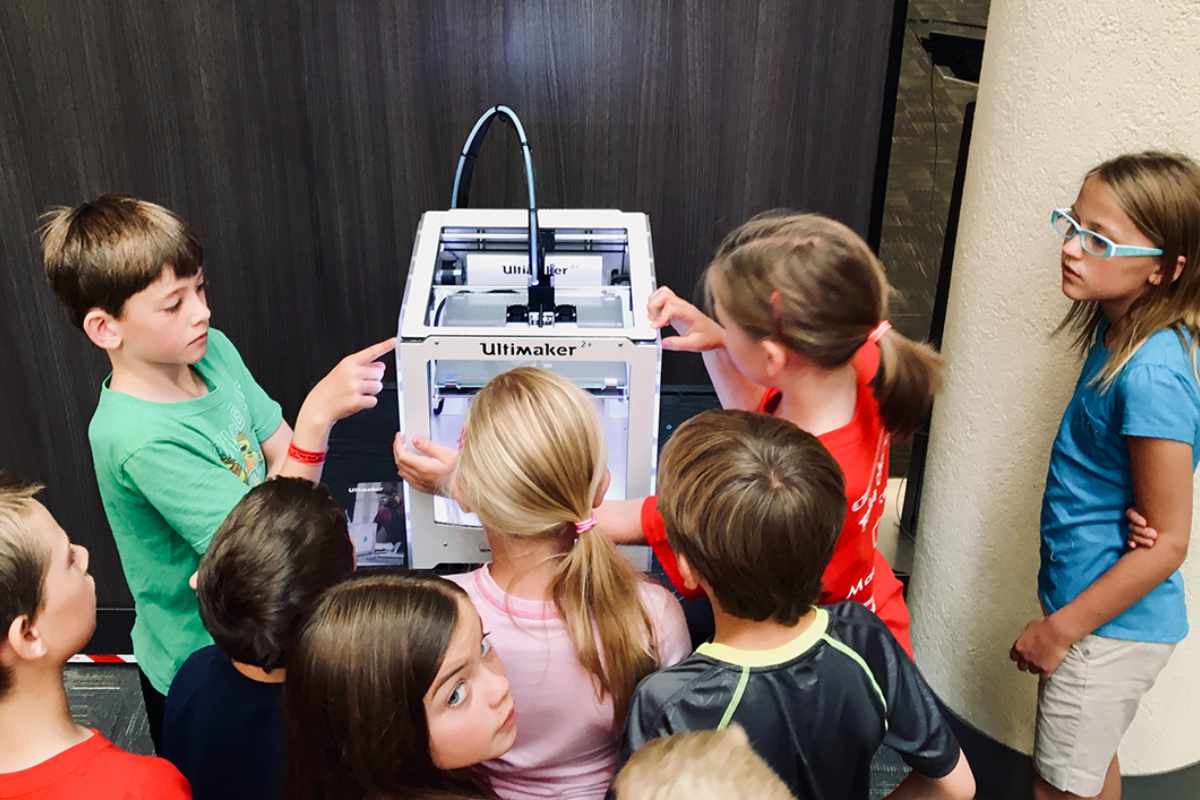
I’m not a science, technology, engineering or maths teacher. Maths? I can’t build complex Dewey numbers for the life of me! I’m a voc-ed teacher and a librarian. My undergraduate qualification is in visual arts! So, what can I say here that will be of interest to you, and how do I get to be the expert on STEM in libraries?
Models of facilitation and inquiry
When I first studied vocational education, we were introduced to a variety of approaches beyond didactic teaching: facilitator, coach, mentor. Over the years, my one key approach has been setting tasks that are inquiry based.
As a library studies teacher at TAFE, I adjust the level of inquiry to suit the student or student cohort and the outcomes I’m assessing. I often utilise an open inquiry approach with a degree of support from class peers. Sometimes I’m a coach, sometimes a mentor an often I’m just an observer.
When developing a STEM course for library practitioners, I looked to incorporate levels of inquiry and independence, seeing my role as facilitating (providing opportunities) rather than lecturing.
Some participants are surprised at first. This often takes the form ‘You are the teacher and I am the learner’, ‘Where do I start?’ or, in response to prompts, ‘I need to directly answer the teacher’s question’, ‘I need to be correct.’ However, most quickly grasp that engaging with the group might help them frame their understanding or reveal new approaches (which is what the teacher wants!).
Most library staff see underpinning approaches to STEM as a good fit for the library. They are used to situations where they may not know all of the answers – but can find out.
In the coursework, participants examine their diverse situations and ambitions and work towards solutions. This could be an initial exploration of setting up a podcast facility, looking at an environment citizen science project, exploring code clubs for over-60s, or researching funding avenues. Participants are encouraged to share ideas and seek like minds.
Within this structure, I have populated the learning environment with prompts and starting and talking points – the ‘ask’ or orientation phase of the engineering process.
Voices of experience
I contacted people in schools and public libraries. My knowledge, and the course itself, was populated by these ‘voices of experience’. I’m not the expert but, just like a librarian, I can find and share expertise. Each year I’ve discovered new voices of experience, in many cases participants from the previous year’s course.
In encouraging sharing and discussion, the course became a place to learn from others. Participants found others with similar situations, or were given different perspectives by those in different situations. Underpinning this is the idea of a community of practice.
I am also a learner. Here are some of the things I learnt from current participants:
- Imposter syndrome often affects girls or women in STEM, but also us, the ‘accidental STEM librarians’.
- Many of us have maker spaces in our homes.
- STEM education at secondary and higher education levels often teaches facts, skills and processes but not critical thinking, particularly in relation to qualitative claims. Libraries can have a role here.
- The disparity between libraries that have and those that have not in terms of space, time and technology is still vast.
- Inclusion is often thought of in an ‘if we build they will come’ way, rather than by identifying and targeting audiences.
- ‘3 before me’. You all know this one, I’ll bet – I didn’t!
There are also numerous valuable voices available through research. Connections magazine, thank you! And of course there is the recognition that participants are in libraries, surrounded by information.
As one voice said: ‘You need to think about who you have around you who can help you – if the expectation is that you do it alone, you can’t. Believe me, I’ve tried!’ While that may relate directly to a staffing situation, it also applies more generally. Ask, network, make friends, see how others do it. Librarians are a sharing bunch – it’s one of the things we do.
Aims
Each year one of the course prompts involves the idea of aims. Why does your library want to incorporate STEM-based activities? The two word clouds (top) from the past two courses visualise participants’ initial thoughts. These are then turned into discussion points.
Fun and learning
The most striking thing is that in both word clouds fun takes centre place. This is borne out by comments throughout the course.
‘Consider the importance of fun! Is everyone having a good time?’
‘I usually have as much fun as the children :)’
‘I think one of the best things about STEM is that … it’s fun learning.’
The connection between learning and fun includes the idea that a library-based approach to learning was likely to be more enticing because it wasn’t a classroom and there were no tests. Failure was reframed as part of a process, but difficulties were also discussed; for example, challenging the common perception of the library as a tidy and quiet space.
STEM activities, programming and collections in libraries are intrinsically linked to individuals and communities developing the ability and desire to learn.
2020
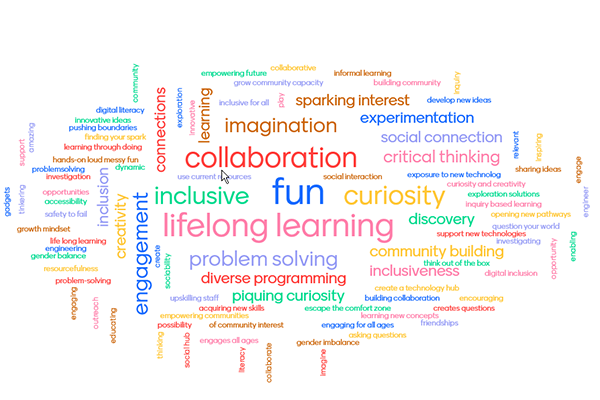
2021
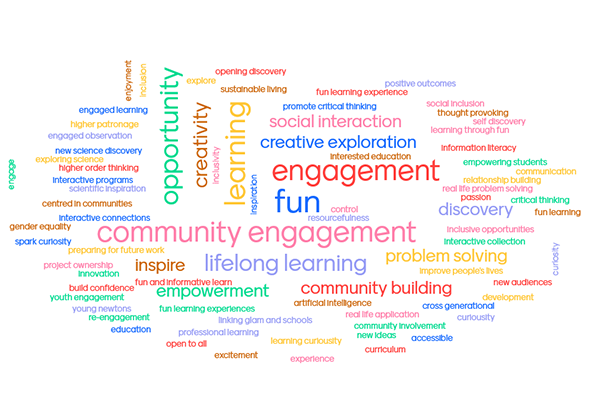
2020
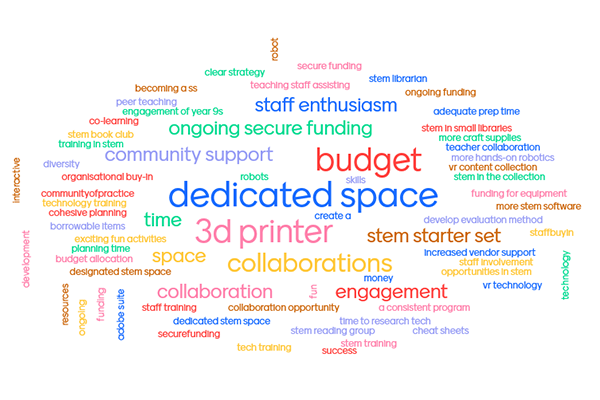
2021
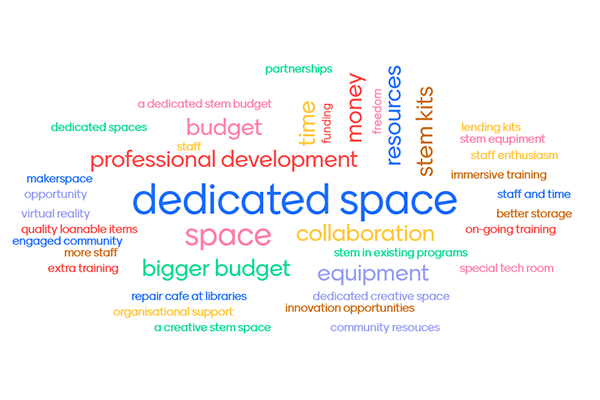
Community and collaboration
The introduction of STEM activities created and developed concepts of, and spaces for, community and collaboration. Libraries and STEM activities can work to develop civil and civic discourse. This might start as early as sharing or asking for Lego pieces. Alongside this is the concept of the library’s place in enabling lifelong learning.
STEM activities, programming and collections in libraries are intrinsically linked to individuals and communities developing the ability and desire to learn. Libraries provide the necessary spaces and resources – with collections of books, databases and also of people. ‘Exploring, observing, discussing and developing awareness’ as one participant put it.
Going forward
At the end of each course, the participants are asked to make three wishes for the future. The collections of words above describe future plans – I’ll leave you with these wishes and encouragement for your STEM adventures!
Image credits:
Main photo by Adam Winger on Unsplash and figures supplied by Gary Lom.